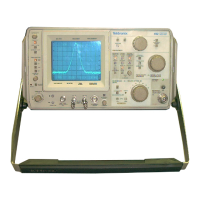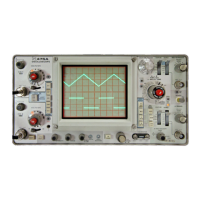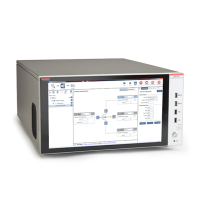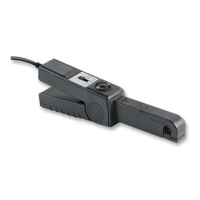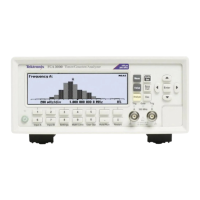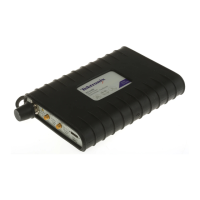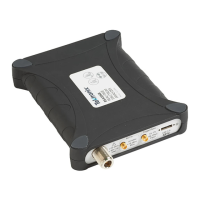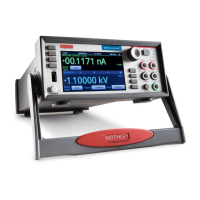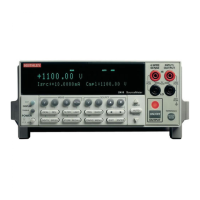The input signal is attenuated through R617 and the input
impedance to Q620, so that an approximate 5 division dis-
play in the LIN position will provide approximately the
same signal amplitude when the switch is changed to either
of the other two positions.
In the SQ LAW position the signal is applied through two
germanium diodes, D612-D613, to the base of Q620. The
diodes are connected back to back to form a square-law
voltage divider. Signal voltage to the amplifier Q260 in the
SQ LAW mode becomes a function of the diode’s dynomic
resistance as shown in Fig. 3-11.
Note that diode resistance exceeds 100 k - for very low
(mV) input signals. The divider ratio is approximately 200:1
so 0.5% of the signal will be applied to Q620. With a 150
mV signal the dynamic resistance of the diode decreases to
approximately 5 k , so approximately 10% of the signal
will be applied to Q620. The circuit will normally have about
70 mV signal for full screen display so the diodes operate
along the steep portion of the dynamic resistance curve.
This no-linear dynamic resistance of the divider produces
a display which emphasizes small signal level differences
between signals. The vertical response for the SQ LAW
display is approximately proportional to the signal power.
Q620 is a high gain amplifier driving the complementary
amplifier Q630-Q631. The complementary amplifier provides
the drive for the step-up transformer T640. This provides
the voltage gain required to drive the LIN detector, the log
circuit, the recorder and the intensifier circuit. The signal
to the RECORDER output connector is a linear signal in the
LIN and LOG positions of the VERTICAL DISPLAY switch,
and square law in the SQ LAW position.
The video detector diodes D640 and D641 are connected
as a voltage doubler for maximum efficiency The output
video signal is then amplified through the emitter followers
Q640 and Q641 and applied through the VERTICAL DIS-
PLAY switch SW600 to the vertical amplifier. Q641 is long-
tailed through R657 to the -10 V supply to provide a constant
DC output level to drive the vertical amplifier, the baseline
suppress circuit and the RECORDER output connector. This
provides minimum baseline shift when the VERTICAL DIS-
PLAY selector is switched between positions.
The logarithmic circuit consisting of R650, R651, R653, D650
and D652 provides a logarithmic display when the VERTICAL
DISPLAY switch is in the LOG position.
Low amplitude video signal voltages appear across D650
with little or no attenuation. As the amplitude increases,
the current through the diode becomes an exponential
function of the voltage across the diode, R650 becomes the
current source for the diode, so the voltage out becomes a
logarithmic function. As the signal amplitude incrases the
diode current approaches the linear region of the voltage-
current characteristic curve; however, this current through
R653 develops sufficient voltage across D652 to turn this
diode
on
and the two diodes operate in series to extend the
logarithmic range of the circuit.
Vertical Amplifier. The vertical amplifier consists of
an operational amplifier driving a paraphase output am-
plifier. The operational amplifier consists of the grounded
base amplifier Q660, driving the emitter follower Q670 and
the inverter amplifier Q680. Output signal from the collector
of Q680 is fed back to the input of the amplifier, through
R672 (Vert Gain adjustment) in series with R671, to the
emitter of Q660. Gain of the amplifier is a function of the
ratio R
f
/R
in
. R
f
is controlled by the Vert Gain adjustment.
POSITION control R665, sets the input DC level to the
operational amplifier which is reflected as a DC shift in
the output level to the vertical output amplifiers. Diodes
D670 and D671 do not normally conduct They limit the
overdrive and speed up the recovery of the amplifier.
The low impedance signal output from the operational
amplifier drives the vertical amplifier output stage. The
output amplifier is connected as a paraphase amplifier to
convert the single-ended input signal to a push-pull drive
for the vertical deflection plates of the CRT, The common
emitters of the output amplifer are connected to a constant
current source Q690, which supplies approximately 2.5 mA
to each output side of the amplifier (or 5 MA total).
Trigger Generator, Sweep Generator and
Horizontal Amplifier
The sweep generator will free run or it may be triggered
by the internal video signal, the line frequency or an external-
ly applied triggering signal.
Sweep rates in a 1-2-5 sequence may be selected for
0.5 s/div to 10 µs/div. The sweep voltage generated by the
sweep generator is amplified by the horizontal amplifier and
applied as a push-pull sawtooth to the horizontal deflection
plates of the CRT.
If the sweep generator IS triggered, the selected trigger
signal is amplified and shaped by a trigger amplifier then
applied to the trigger generator. Trigger signal level and
slope can be adjusted and selected.
The trigger pulse from the trigger generator switches
a sweep gating multivibrator to generate the unblinking gate
for the CRT during sweep time and initiates the operation of
the sweep generating circuit.
The sweep generator supplies a linear and timed ramp
signal to the horizontal amplifier plus a feed-back signal
to the trigger generator. This feed-back signal locks out
or holds off the trigger signals to the sweep gating multi-
vibrator until the sweep has run and the circuit is ready
again to be triggered.
Trigger Generator. The selected trigger signals from the
SOURCE siwtch are AC coupled through C701 to an opera-
tional amplifier Q700, Q710 and Q720. The output of this
operational amplifier is a low impedance signal that drives
one side of a comparator amplifier Q730-Q731.
The input DC level to the operational amplifier is set
by the trigger LEVEL control R702, and the Trig Level Center
adjustment R724. This input DC level to the operational
amplifier also governs the output DC level of the amplifier
which is the input level to the comparator Q730-Q731,
One side of the comparator is referenced through the
SLOPE switch SW720 to ground, while the other side is
connected through the SLOPE switch to the output of the
operational amplifier. The Trigger LEVEL control adjust the
DC level, on the signal side of the comparator, to a voltage
potential above or below ground. The input trigger signal
must overcome this unbalance to trigger the trigger generator
3-12

